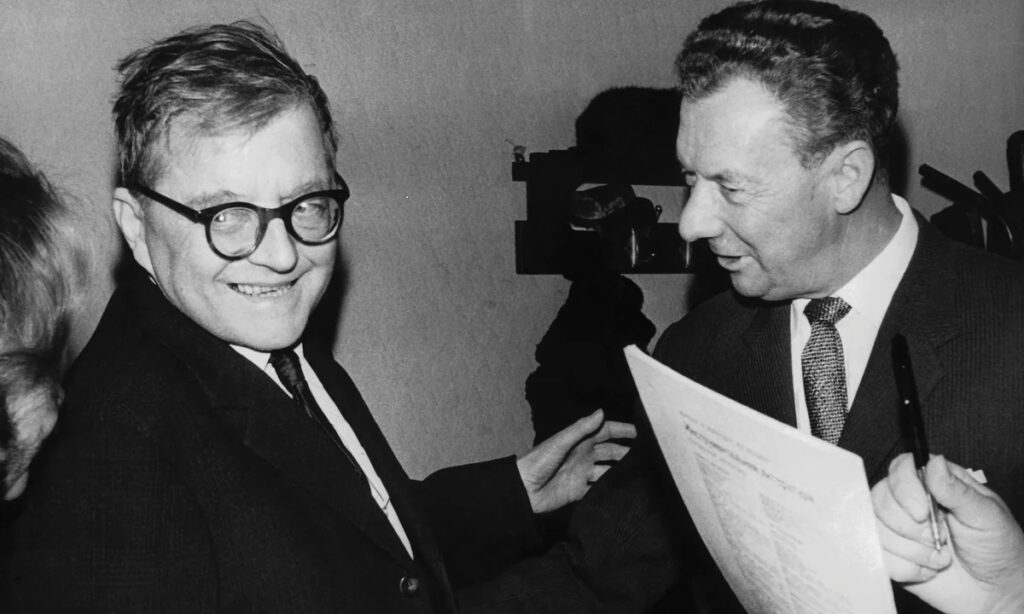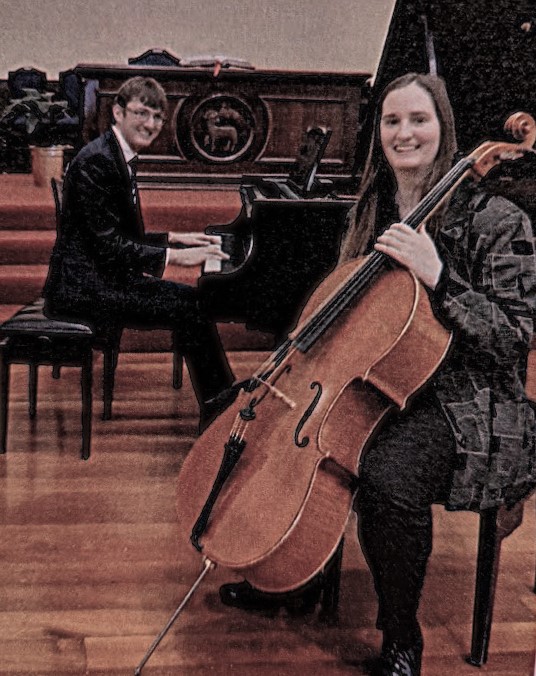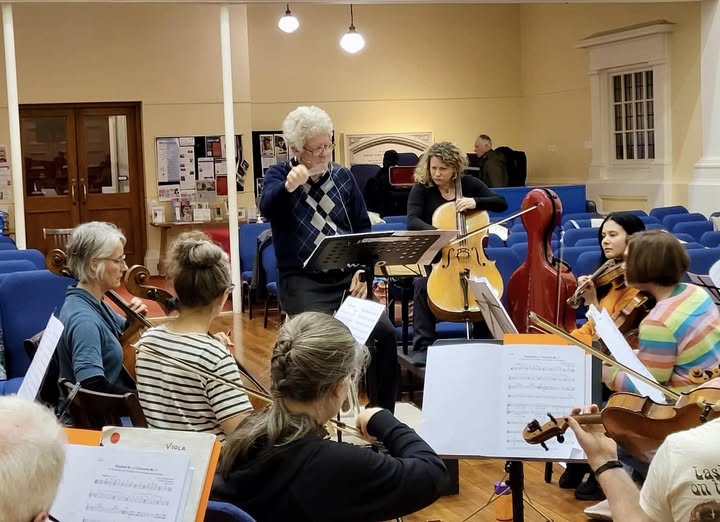JS BACH – Suite No. 3 in C Major for Solo Violincello BWV 1009
Rolf Gjelsten (‘cello)
DMITRI SHOSTAKOVICH – String Quartets: No 5 in B-flat (1952) / No. 2 in A Major Op. 68 (1944)
The Chamber Pot-Pourri Ensemble:
Helene Pohl, Simeon Broom (violins), Nicholas Hancox (viola), Rolf Gjelsten (’cello)
The Long Hall, Roseneath, Wellington
Saturday, 18th November, 2025
“Wuthering Heights” might have been an apter name for Roseneath’s “The Long Hall” on Saturday afternoon, when Wellington’s Point Jerningham resoundingly lived up to its reputation as the windiest spot in the capital during a concert given by the Chamber Pot-Pourri Ensemble, one in which the wind played at pedal points, drones, and vigorous ostinati as constant accompaniments to the music-making. The latter, of course, persisted and eventually triumphed, with the players’ all-pervading focus on the music happily relegating such disruptions, however tumultuous, to an incidental, scarcely noticeable in situ degree.
The Ensemble’s quartet personnel has undergone fascinating and fruitful variation over the year, in particular regarding a second violinist, and featuring luminaries such as Monique Lapins, Anna van der Zee and Peter Gjelsten in the position. For this concert the player was Simeon Broom, currently an NZSO member with a number of years’ valuable experience spent in various orchestras overseas. Each of the quartet performances in this concert demonstrated both the group’s flexibility and individual members’ skills at adaptation to fresh combinations, auguring well for continuance of presentation by the ensemble of one of chamber music’s core repertoire resources.
As well they might for the purposes of such an exploration of what is becoming increasingly apparent to me as one of the great cornerstones of musical expression of its time and its relevance for other times – Dmitri Shostakovich’s fifteen string quartets. Though Beethoven’s acclaimed cycle of quartets would seem like an obvious inspiration to any aspiring composer tackling the same genre of works, Shostakovich’s relationship with the form took a different path over time, with the young composer, mindful of his experience with the 1936 “Lady Macbeth affair”, all too aware of those repressive conditions foisted upon creative artists within his homeland, and thus taking care with his first string quartet venture (1938) to avoid any undue excess. It was six years before he returned to the medium in 1944, confident then of giving an impression of a loyal Russian’s patriotic response to the war effort via his references in the work to Russian folk music, though the ethnic elements in this second quartet included definite references to Jewish “Klezmer” music, perhaps more for aesthetic reasons than political ones. The Third, Fourth and Fifth Quartets were less fortunate, with the composer’s increasingly dysfunctional relationship with Stalin and his cohorts resulting in his regarding the works as “for the drawer” – the Third Quartet (1946) received one performance before being withdrawn), while the other two (the 1949 Fourth and the 1952 Fifth) languished unperformed until after Stalin’s death in 1953.
Of longer-term interest is Shostakovich’s love of the music of JS Bach – he headed a Soviet delegation in 1950 to attend in Leipzig events marking the bicentennial commemoration of Bach’s death , where he was quoted as saying “For us Bach’s legacy is an embodiment of flaming emotion, soulful humanity and true humanism, which stands in contrast to the dark world of raw evil and contempt for humanity.” Shostakovich knew the Well-Tempered Clavier intimately (he had been playing it from the age of twelve), when he encountered the 26 year-old Tatiana Nikolaeva playing selections from the work at the International Bach Competition which was one of the Leipzig bicentennial events. Her playing (which won her the competition’s first prize) inspired Shostakovich to compose his own set of 24 Preludes and Fugues, and dedicate the set to Nikolaeva, who premiered them in December of 1952 (she subsequently recorded them no less than three times!).
These Op.87 Preludes and Fugues provide a thoroughly refreshing look at musical examples of the art we readily associate with Bach – counterpoint, fugue and texture, a dynamic collection of captivating opportunities for what one commentator has described as “musical ecstasy and reflection”. And, as ‘cellist Rolf Gjelsten pointed out in his pre-concert talk today prior to playing for us Bach’s heart-warming ‘Cello Suite No.3 in C Major, the work’s confidence, ebullience and mastery of form is a representation of the effect on Shostakovich’s own use of counterpoint and fugue in certain of his quartets, especially evident in the 1944 Fifth Quartet which we were to hear immediately after this work.
I’d recently been enjoying former Wellingtonian cellist Miranda Wilson’s “The Well-Tempered ‘Cello” (published 2022, Fairhaven Press) , describing her own saga of getting to know, working on, and eventually performing these ‘Cello Suites – so the section of the book devoted to this Third Suite occasioned some required (re)reading and (re)relishing! She emphasises the work’s in-built resonances, being in the C-major key, and Rolf Gjelsten seemed to confirm this with his verdict regarding the work’s general affability and out-going nature – music with plenty to say and with the resonances created that supported this kind of character.
Right from that opening “downward plunge” into Bach’s flow of notes I felt a wonderful sense of well-being – the journey at first was mostly scalic, but with some wider steps and a couple of quirky jumps, and a voice which grows in variety of expression, passing through single notes, phrases, lines and episodes, and with an engagingly droll drone-sequence around the note of G, before a few moments of recitative bring us to the end. The Allemande contrasts with the bright-and-bushy-tailed Prelude in being so gorgeously relaxed in its graceful trajectory, the sudden chain of double-stopped notes in the piece’s first half, a brief frisson of tension that resolves with a nudge of extra warmth. Rolf had told us about the Courante with its “crazy dance” aspect (Miranda Wilson refers to the piece’s “frantic-up-and-down arpeggios”!) – and to my untutored ear it seemed to possess and swap between two kinds of rhythmic trajectories at will, with beat-stresses changing as if playing a kind of game with my sensibilities!
The Sarabande, my attendant author’s “powerfully moving” rhythm, is similarly characterised by my in situ player as having “a unique kind of intensity” – I didn’t know before this concert that it’s a dance form that was banned in the 17th Century as eliciting “too erotic” a response from its participants! I’ve now been dangerously over-sensitised to its allure, and will have to watch myself over that second note in each bar, in future! I catch myself savouring it during the performance, here, and thinking that it must be a case of “once heard, etc….!”
The Bourees plucked me our of any such fantasy world I might have ventured into. They’re wonderful, “two-sides to the coin” dances, suggesting different physical, psychological or emotional views of the same location, feeling, or situation. Here the difference seemed like a masculine/feminine distinction, a somewhat conventional response, I know, but one which a lifetime of observation has ingrained for good or ill! And I loved the Gigue, here, with its almost lazily loping stride, and especially the bariolage sections (one note repeatedly sounded in the midst of a whirl of others) which have always had a pleasantly astringent “ring”, and which were followed with a reassuring “that’s enough of that” rejoiner!
So, onto the first of the Shostakovich offerings of the afternoon we went, with the wind just as fulsomely attendant as ever! The Fifth String Quartet appropriately back-ended the Bach Suite performance, allowing the former’s compositional proximity to the composer’s own 24 Preludes and Fugues to resonate more readily, the earlier Second String Quartet having a rather different, and more removed kind of genesis. I was intrigued by other references I’d found to this later quartet’s influences, among them the music of one Galina Ustvolskaya, a former pupil of the composer’s and one he apparently harboured deeper feelings for, following the death of his first wife – Shostakovich quotes a four-note motif from Ustvolskaya’s B-flat Clarinet Trio, played by the first violin in the quartet’s first movement coda (the composer’s feelings, incidentally, were never returned, adding to the poignancy of the quote).
In his introduction to the work for us Rolf Gjelsten emphasised the composer’s predicament at having to indefinitely defer some of his music’s performances, such as this Quartet (along with his two previous quartets, one of which did get a “premiere” but was then withdrawn!). Stalin’s death in 1953 meant that this Quartet could at last come in from the cold, along with a number of other important works “awaiting their time”. It was the first of the composer’s Quartets which joined the movements together in a single sweep, and it contained a number of unusually “personal” references – elements which would come to increasingly characterise the quartets still to come.
The work’s striking opening contained a “walking” theme whose determined trajectories were set upon by trenchant figures whose intensities assailed the music until the second violin’s introduction of a more lyrical subject tossed about between the players. Gradually the mood intensified further, with both the walking and lyrical themes returning but under siege, the lines buzzing like fierce insects, out for blood, but then gradually receding as, firstly, the lyrical theme made an impassioned return, and then, from nowhere, came the aforementioned Ustvolskaya quote on the first violin, disappearing after a second, higher, more ethereal statement as the instrument took the music via a single note and accompanied by pizzicati, to the next movement.
Here, the lines portrayed a kind of stillness, a post-rampage desolation, in places a kind of austere beauty, with eerie unisons and soulful phrases clasping the ambiences and holding them fast, until the viola, obeying a lonely impulse stepped forwards with an engaging phrase in hand to begin the dance, a tart little waltz whose good-humoured gesturings gradually turned once more into the furies that beset the opening movement. And just as unexpectedly as in the opening movement, the tumult ceased, and first the violin, and then the viola impassionedly sounded the Ustvolskaya theme once again, punctuated by emphatic pizzicati from the others. As with its first appearance the theme gave little solace, more a sense of something out-of-reach, emphasised by the subsequent “walking away” of the music, the jog-trot of the finale’s opening leading to a bleaker, much reiterated theme which then dissolved into silence.
After giving us such a “living and breathing from within” response to this work’s emotionally searching sound-saga, the players allowed us an interval’s space before launching into the stunningly contrasted physicality of the opening “Overture” to the composer’s Second String Quartet , written in 1944 – music sounding for the moment relatively free from the constraints of politics or dogmas, its folkishness serving both as Shostakovich’s loyal citizen-response to the “Great Patriotic War”, and in particular his fondness for Jewish klezmer-like idioms in the exuberant opening theme, here suggestive of a folk-celebration.
Though this remained an ensemble performance overall, throughout the work’s second movement I couldn’t help but be overwhelmed by the charismatic violin-playing of Helene Pohl in her delivery of the piece’s klezmer-like solo, mournfully expressive soliloquies over drone-like accompaniments, and with the occasional notes ambiently “bent” in what one presumes is an authentic style. At one point the ‘cello sounded a brief solo before the violin began a slow waltz, one into which melody the other instruments gradually climbed, their notes rising to agitatedly “connect” with the violin’s before falling away once more – for most of this movement the violin is played as if it has joined with its player at prayer…..
A nocturnal scherzo/waltz followed, swift, ghostly and chromatic, a real danse macabre, alternating between substance and shadow before taking its “do I wake or sleep?” leave. In its enigmatic wake was left the finale, an astonishing theme-and-variations movement, recitative-like at the beginning between the instruments , settling down to expound and extract every ounce, strand and tone of the folk-tune introduced by the viola, and then refracted through what seemed like all possible combinations, and every single conceivable characteristic one might ascribe to the composer’s experience. All the players here – violinist Simeon Broom, violist Nicholas Hancox and cellist Rolf Gjelsten – brought into play intensities and virtuosities echoing those of Helene Pohl’s brought over from the previous movement, carrying the music through its tumultuous journey to a monumental conclusion.
I managed a few grateful words of breathless appreciation to Rolf Gjelsten at the end – and then, afterwards, the still-insistent winds were good company as I walked home, drawing out the music’s tumultuous resonances from my memory and setting them dancing in the open air, art and nature joining hands in an unexpected post-concert bonus!


 Donald Maurice (conductor) and Inbal Megiddo (‘cello) rehearse Shostakovich with the Wellington City Orchestra, December 2024, at St.Andrew’s Church, Wellington
Donald Maurice (conductor) and Inbal Megiddo (‘cello) rehearse Shostakovich with the Wellington City Orchestra, December 2024, at St.Andrew’s Church, Wellington